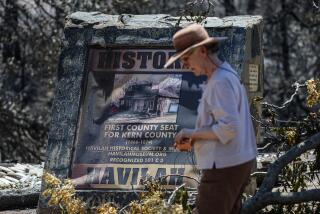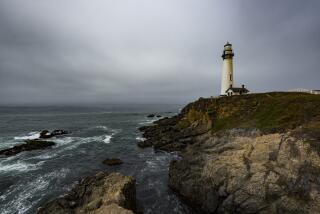Town Hopes Its Past Ushers in New Gold Rush
BAKER CITY, Ore. — When they strung up poor Bogs Greenwood on a ranch near here in 1864 for murder, most probably figured it was the start and finish of his moment of fame.
But when they tore down a Main Street bank building decades later they found a time capsule, and there was Bogs’ skull, along with a brief biography.
The skull and its libretto are missing, but a plaque on the replacement building tells all about it.
And that tells a lot about Baker City.
The town is within spittin’ distance of the Oregon Trail, and later, when the mines were belching gold, how the money rolled in.
But with the mines silent now, and the timber industry in shards, Baker City’s future may be defined by its past.
The town changed its name from Baker City to Baker in 1911 because the former seemed a bit old-fashioned. It changed back a few years ago for the same reason.
It was named for Edward Baker, Oregon’s first U.S. senator, who was a close confidant of Abraham Lincoln and the only congressman killed in the Civil War. Lincoln named a son after Baker and another Lincoln son wrote a poem mourning Baker’s death. The poem was awful.
The people in their stiff poses and derby hats of the ancient photos are long gone. But much of Baker City looks as it did.
Grants and private money have paid for removing the boring makeovers of the old buildings, returning them to their old selves.
“The reason they weren’t torn down long ago is that there wasn’t any money to do it,” said Beverly Calder, a history buff who owns a deli and wine shop in the town’s historic district.
Since then, she said, Baker City has realized the value of its past.
Plaques on the older buildings give a hint of the town’s hell-roaring days.
Part of one side of Main Street was given to the baser instincts, where the Salvation Army trolled for lost souls and where respectable people didn’t walk. More genteel commerce held sway across the street.
Calder’s shop once was on the “shady” side of Main.
“Older women told me not to open it there, that ladies would never shop there,” she said. “This was in 1998! But they remembered how it was as recently as the 1930s and ‘40s.”
Baker City was built to support an Oregon gold rush. It had trolley lines, an opera house and the Geiser Grand Hotel, then and now the town pride, which opened in the 1880s and was said to be the finest between Portland and Salt Lake City, with the third elevator ever built west of the Mississippi.
It fell on hard times, but a $7 million makeover has painstakingly restored it. More than 100 cut-glass chandeliers (the originals vanished long ago) dangle from its high ceilings. The hardwoods glisten and the stained glass ceiling in the dining room defies description.
It is said by some to be haunted, but a recent visit turned up no nonpaying guests.
The county was rough enough to inspire commentator Walter Winchell to remark that if you wanted to kill someone, Baker County was the place to do it.
Baker City has had a population of about 10,000 people for decades.
It is a jumping-off point for the Snake River and Hells Canyon, the nation’s deepest, a magnificent Oregon Trail Interpretive Center and a collection of ghost towns left over from the 19th century gold rush.
As gold rushes go this one was a beauty, but as gold rushes go it went. Most of the towns it spawned flourished and some, such as Sumpter, Auburn and Sparta, were among the largest in the state.
Auburn, where it all began, was a rip-snorter in the 1860s, the state’s second-largest town at about 5,000 residents, the county seat and a candidate for state capital.
In his memoirs “The Golden Frontier,” (University of Texas Press, 1962) prospector and teamster Herman Reinhart recalls the fate of a man known only as a “Spainard” (sic) who killed two men in a knife fight over cards.
The miners “fired his cabin and he had to come out and they threw a rope around his neck and dragged him through the street, filled his body full of bullets, hung him up and strangled him and shot him to death and threw him into his burning cabin. ... “
Tough times. Tough town. Tough people.
Nothing’s left of Auburn now except a cemetery that’s hard to find.
Hobby miners still find gold in the streams and rivers, but the big operations are gone, silenced largely by environmental regulations and high costs.
“There’s not much of the easy gold left to be found,” said Terry Karp, owner of Baker City Gold and Silver, which has a good display of gold found in the area. “And 90% of what they find is like that in this vial of dust.
“And environmental laws say you can’t put dirty water back in the creeks, that sort of thing.”’
It wasn’t always like that. The Armstrong Nugget, a 5-pounder found in 1913, is on display at the U.S. National Bank, along with a good display of other samples of gold from the area.
The massive Sumpter dredge, still intact in nearby Sumpter, was one of three that took some 9 tons of gold from the Sumpter Valley. At today’s price of about $400 an ounce that would total $115.2 million. Millions of dollars more came out of other mines.
The dredge is a state heritage site today, free for the public to explore. You can ask questions at a small gift shop. Buy an inexpensive gold pan if you want to try your luck, or buy a tiny nugget of Baker County gold for as little as $5.
Seven large area claims are held by Eastern Oregon Miners and Prospectors Inc., a nonprofit that sells family memberships for $50 a year. Six of the claims have basic camping facilities.
Closer to Baker City is the Oregon Trail Interpretive Center on the actual Oregon Trail, a museum that does a superb job of bringing the Great Migration to the West to life.
The life-size wagon replicas and excerpts from diaries debunk many myths. Most of the pioneers didn’t ride on the 1,900-mile trip in the billowy prairie schooners of Hollywood. They walked, sometimes barefoot, to Oregon’s Willamette Valley, described by one pamphleteer as “a place where God tempers the wind to shorn lambs.”
But getting there wasn’t so pleasant, and by the time the pioneer trains reached Eastern Oregon they were in rough shape.
Oxen were dying, heirloom furniture had been jettisoned, the pioneers were exhausted, many had perished and there were still mountains ahead.
Winter was coming.
Most had sold everything for the trip, and there was no going back. You can stand on the trail, still visible after tens of thousands of wagon wheels formed it, and wonder how on earth they made it.
The museum documents it all with diaries, photos, and careful replicas in displays that put the era in context.
“Nothing but rock upon rock, nothing but sage,” recorded Esther Hanna in 1857.
“The roads here is very deep, dust something like hot ashes,” George Belshaw recorded four years earlier.
“A lazy person should never think of going to Oregon,” wrote another.
More to Read
Sign up for Essential California
The most important California stories and recommendations in your inbox every morning.
You may occasionally receive promotional content from the Los Angeles Times.










